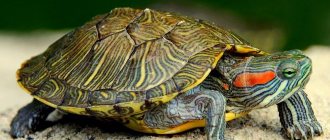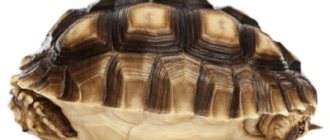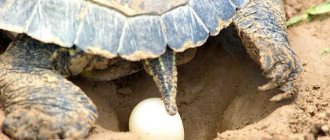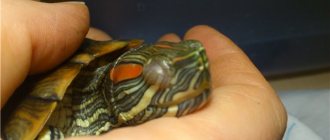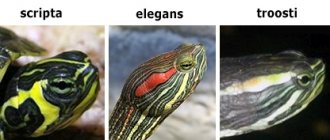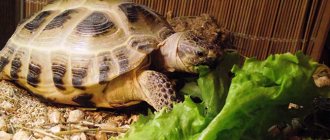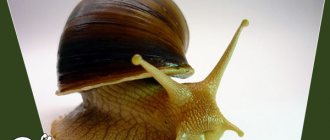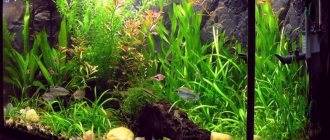The owner of a red-eared slider begins to feel anxious at the slightest change in the behavior of his pet, especially when the reptile refuses to eat. Some cases are completely safe and the animal’s health is not in danger.
In order to understand the situation, you should determine the cause that led to this condition and, if possible, begin to eliminate it. Not always independent intervention can be beneficial.
In order not to harm or worsen the situation, it is best to consult with specialists or experienced owners.
How to determine if your pet is hibernating
It is quite difficult to distinguish hibernation from death if you do not know certain signs of a living reptile in suspended animation and a dead turtle.
What signs indicate the death of a pet:
- Open mouth.
- Lack of response to light and pain. Shine a light into the reptile's eyes and try to prick its paw with a toothpick.
- Sunken eyes (does not always indicate death).
- Unnatural color of mucous membrane. In living individuals it has a pinkish tint, in dead ones it is gray with a bluish tint.
- Lack of response to heat. Place the reptile in warm water or near a light heat source.
- Rotten corpse smell. The smell appears a couple of days after death. You will most likely notice obvious external signs of decomposition.
If the signs of death are not obvious, for example, sunken eyes, you should contact a specialist at a veterinary clinic, who will determine what is wrong with your pet.
Signs of hibernation
The state of wintering is often confused with death. To put your mind at ease, check your red-eared slider for several points that will help you understand that it is definitely hibernating:
- Jaws
. Try to pull your lower jaw down and leave your mouth open. The reptile should try to close its jaws. - Eyes
. A cold metal spoon placed against your pet's eye should trigger the corneal reflex. If the turtle tries to retract the disturbed organ or opens its eyelids, then there is no reason to worry. - Reaction to heat
. A hibernating red-eared turtle placed in a container of warm water (30°C) will begin to move its paws.
Otherwise, signs of hibernation include:
- Decreased activity
. The pet behaves lethargically, hides in a corner of the aquarium, remaining motionless, and refuses to leave its house for a walk. - Poor appetite
. In addition to loss of activity, the reptile refuses its favorite food and reduces its usual amount of food. - Increased sleep duration
. Long periods of rest are accompanied by frequent yawning.
Conditions for keeping red-eared turtles
For one animal you need an aquarium with a volume of one hundred to one hundred and fifty liters and land connected to water using a rough ladder. If there is insufficient space, the turtle will not swim or move.
In addition, the following conditions must also be met:
- The surface of the land in the turtle's home should be large enough, sloping, rough and gradually rising. Special islands sold in stores meet all the necessary requirements;
- The water temperature in the aquarium should be higher than room temperature. To heat it, you should purchase a thermostat;
- the air above the island should also be warm, so it is recommended to install an incandescent lamp above it;
- the island should be at a level of thirty centimeters from the edge of the aquarium. If it is located close to the edge, nimble pets can escape;
- The water is cleaned using external aquarium filters. The frequency of water changes depends on their effectiveness. The cleaner the water in the aquarium, the faster the young turtles will grow;
- animals need sunlight, so in the summer they need to be walked with, and in the winter irradiated with ultraviolet light. A UV “Tanning Lamp” is suitable for this; it will need to be used three times a week for four minutes at a distance of thirty to fifty centimeters.
During a walk, the animal should be protected from direct sunlight, walking dogs and crows.
Who is better boy or girl
Visual differences between males and females in turtles appear after puberty is complete. Until two years of age, it is impossible to accurately determine whether a boy or a girl is hiding under the shell. For solitary confinement, the difference is not fundamental.
Females of any turtle species will carry out their natural program of laying eggs, even without contact with a male. If more than two years have passed since the last meeting with a representative of the opposite sex, there will be no offspring. The reptile's body requires vitamin support during this period. In rare cases, the process can negatively affect the health of the pet. Male land turtles are usually noisier than females. They are more active and more likely to show aggression.
If you need to choose a second turtle, the introduction will have to be carefully planned. Boys of any breed rarely get along with each other. Girls are more suitable for pair housing. When an opposite-sex couple lives together, the male can oppress the female. Turtles feel comfortable alone.
Reasons for refusing to eat
One of the first reasons why a turtle does not eat is simple overfeeding. But besides this, there are a number of situations that can affect the reptile’s appetite.
It is immediately worth noting that turtles are cold-blooded animals and due to changes in the environment or living conditions, they can significantly slow down their metabolism. Adults can go without food for up to three months. In this case, up to 40% of body weight is noticeably lost. It is worth understanding that prolonged fasting can result in exhaustion and negative health consequences.
Conditions in the terrarium
The terrarium you create should be comfortable for the animal in all respects. Conditions should resemble natural habitats. Any changes can affect the mood and health of turtles:
Temperature. This may be the root cause and answer to the question of why the turtle does not eat for a long time. The optimal temperature should be between 25-27 degrees. If a turtle is cold, it becomes inactive, may sleep a lot and even hibernate. Lighting. Poor lighting can also affect reptiles' appetite and mobility
It is important that the lamp has ultraviolet radiation. It is this kind of lighting that helps the body produce vitamin D3. Water
Make sure there is always clean and fresh water in the sippy cup. Often a turtle may refuse to eat due to thirst. Food. Perhaps your pet is not satisfied with the food offered. Remember that food should be varied and appropriate for food supplies. In addition to plants, try giving herbivorous turtles branches of fruit trees and sunflower seeds. For predators, provide a variety of animal foods. It happens that a reptile simply loves a certain product and is waiting for it.
Pregnancy. If a turtle does not eat during pregnancy, this means that the animal feels restless, so it may lose its appetite for 2-3 months. Puberty. This is an important factor that can affect your pet's appetite. Eye Diseases If your reptile feels well and is not pregnant, but still refuses to eat, pay attention to its eyes. The cause of starvation may be conjunctivitis. The fact is that turtles find food through vision (not smell), and swollen eyelids can simply interfere with the search for food.
In addition, if there are two individuals of the opposite sex in your aquarium, then mating games can be the result of poor appetite. Of course, at this moment there is no time to eat, but after mating the animals will definitely renew their strength and eat more than they should. There is no need to be surprised or worry about this.
Disease
Could your turtle be sick? After all, sick turtles eat poorly, become apathetic and lethargic. Exhaustion of the animal can lead to the worst, and the worst is death. The most common cause of digestive and nutritional problems is intestinal parasites. Therefore, owners of exotic animals should, if they suspect digestive problems, collect the animal’s feces and submit it to a veterinarian for analysis.
So what can you do if your reptile stops eating? First of all, you need to examine the turtle externally, monitor its behavior and general condition.
Let's look at the diseases and their external signs:
| № | DISEASE | EXTERNAL SIGNS |
| 1. | Conjunctivitis | Swollen eyelids, pus is often visible under the eyelids |
| 2. | Pneumonia | An aquatic turtle floats to the surface of the water and does not sink, breathes through its mouth, wheezes and blows bubbles, and falls on its side. |
| 3. | Tympany of the stomach | Rolls over on its side, sits on the surface of the water (on a stone or snag), does not drown |
| 4. | Diseases of the oral cavity (herpes, necrotizing stomatitis or herpesvisor) | Heavy breathing, decreased activity, presence of yellow flakes in the mouth |
| 5. | Kidney failure | Passivity, presence of blood under the abdominal shell. Unfortunately, these symptoms appear only in the last stage. In this case, treatment is already useless |
What to do when a disease is detected? In all cases, you cannot do without a visit to a professional. If you react in time to external signs of illness, treatment will be quick and successful, and the animal will soon begin to eat well and lead an active lifestyle.
Hibernation
Under natural conditions, when cold weather or unbearable heat sets in, free-living reptiles hibernate, during which metabolism slows down, sexual cycles in males and females are synchronized, and hormonal regulation is normalized. Thanks to this physiological feature, turtles can go without food for a long time in winter and summer.
Domestic red-eared turtles do not need to hibernate; they are kept in comfortable conditions all year round and receive sufficient food. But for some individuals in the fall, due to a decrease in daylight hours, lack of central heating, or as a result of instincts, life processes slow down, the animal stops eating dry or natural food, becomes lethargic, looks for a dill corner, and tries to hide. If a turtle is not active in October-November, hardly swims, often lies on land and has not eaten for 2 weeks, the animal is most likely hibernating.
What should you do if your red-eared turtle hibernates and stops eating?
A sleeping reptile must be placed in a small aquarium with a minimum amount of water; the bottom must be covered with soil at least 10 cm thick. An adult animal will hibernate for 4-5 months, the optimal hibernation temperature is +6-8C. First, turn off the lighting lamps and keep the animal for 3-5 days at room temperature. Then, over the course of 10 days, it is necessary to gradually lower the temperature to +6C; with a sharp decrease, the animal can die instantly. The reptile is brought out of hibernation by gradually increasing the temperature and bringing it to optimal values as the animal wakes up.
Binge eating
If you are a beginner and have recently acquired such a pet, it means that you have overfed the creature. Inexperienced breeders ask the question: “Why doesn’t the red-eared slider eat anything?”, because they themselves know the answer very well. That's right, it's all about frequent feeding. An adult turtle eats three times a week, and not every day, like a juvenile.
Therefore, do not even try to find out how to force a turtle to eat. Wait: your pet will get hungry very soon, and feed him. Constantly give the animal exactly as much as it needs for normal life. Keep under observation: diet and routine.
A beginner, looking for an answer to the question: what to do if the red-eared turtle does not eat or drink anything, may be surprised. After all, this species of reptile does not drink at all. She gets fluid from food and during bathing. If your pet is dehydrated, try to give your pet only succulent food.
Improper care
Reptiles are cold-blooded animals whose metabolism slows down when environmental conditions change, as a result of which the animals move little and do not eat. Comfortable temperature for red-eared turtles is +26-28C in water and +28-32C on land with a day length of 12-14 hours. When keeping a pet in other conditions, the turtle becomes inactive and eats poorly; in such conditions, the animal becomes vulnerable to the action of pathogenic microorganisms and fungi.
What to do if the turtle stops eating due to violation of the conditions of detention?
To prevent the reptile from getting sick, it is necessary to keep the red-eared turtle in clean, settled water at the optimal temperature; the aquarium must have heating islands and a cleaning system. A prerequisite for the normal functioning of reptiles is the installation of a fluorescent and ultraviolet lamp, as well as balanced feeding with a high content of protein products.
What do red-eared turtles eat?
The natural diet of this reptile consists of small fish, crustaceans, aquatic mollusks, and insects. They eat plants, obtaining from them the necessary vitamins and fiber. When kept at home, the turtle is fed with low-fat fish (leave the bones in the fish, grind the large ones), liver, shrimp, squid, and snails. The meat is not thermally processed. Plants include dandelion, plantain, and lettuce.
Often a small turtle will not eat when fed vegetables and greens. Juveniles are predators; Vegetables, fruits, and herbs cannot be given to them. Until the age of two, they are fed every day, then two or three times a week. Do not overfeed the animal, otherwise obesity will occur. In half an hour, the turtle should have time to eat the entire portion.
Take care of your beloved animals and do not forget that we are responsible for those we have tamed. Let your pets always be healthy, cheerful and please their owners with their behavior.
Improper feeding
Perhaps the red-eared turtle does not eat because it is given the wrong food. She needs animal and plant food. Reptiles should be given lean meat: beef, poultry, horse meat is also suitable. But pork and lamb are contraindicated for turtles, since they are too fatty and the animal’s gastrointestinal tract is not designed to digest them.
In addition to meat, your pet can be given offal. To prevent calcium deficiency in the reptile's body, the diet should include shrimp and low-fat sea fish, which should be given along with bones. You can give raw snails and squid.
But in the absence of plant food, the animal will develop hypovitaminosis and other health problems. You can give dandelion and plantain leaves, carrots, beets, pumpkin, cucumbers, and zucchini.
The older the pet is, the more plant foods should be included in its diet.
But small turtles may refuse if they are given vegetables and fruits; they prefer animal food.
You should not give your pet boiled or fried foods, bread, or dairy products (except cottage cheese).
It is also important to follow the reptile's feeding schedule. She may be fed too often and given too much food.
While the turtle is small, its age is less than 12 months or its size is less than 10 cm, it is fed daily. Adults are given food 2-3 times a week. To determine the volume of one serving, you need to see how much the reptile eats in 30 minutes and give this amount constantly
She may be fed too often and given too much food. While the turtle is small, its age is less than 12 months or its size is less than 10 cm, it is fed daily. Adults are given food 2-3 times a week. To determine the volume of one serving, you need to see how much the reptile eats in 30 minutes and give this amount constantly.
Why doesn't the red-eared slider eat?
Turtles are cold-blooded animals that, depending on the environment and the state of the body, can slow down their metabolism. Therefore, adults can go without food for three months. At the same time, they use their body reserves
and lose forty percent of their weight. However, long enough starvation of a pet can lead to severe exhaustion of the body and various diseases.
Possible reasons
An animal may refuse food for several reasons:
- wrong content
. The main condition for the life of these cold-blooded animals is an ambient temperature of twenty-six to thirty-five degrees. Therefore, if the pet not only does not eat, but also moves little and does not open its eyes, then you should look at the readings of the water thermometer. If the water temperature is within normal limits, then the reason for the turtle’s refusal to eat is something else; - suppression of weak individuals
.
If there are several red-eared turtles in one aquarium, then the hardiest individuals can dominate the weaker ones
and take food from them. Therefore, oppressed animals should be fed separately; - poor nutrition.
If a young red-eared slider is not eating, it may have been switched to adult food early on. Only after a year can pets be given meat, eggs and fish; - change of season.
From October to January,
turtles begin to respond to shorter days
and therefore eat less. Starting in February, after daylight hours begin to increase, pets will begin to eat again; - sexual behavior.
If the animal begins to behave more actively, but at the same time eats little, then most likely it is a male. During sexual activity, they suddenly stop feeding and become restless. After the mating season is over, the animal's appetite will be restored; - diseases.
If, as daylight hours increase and the ambient temperature rises, the turtle refuses to eat, then it needs to be shown to a veterinarian.
During wintering, animals not only do not eat, but also do not drink. This leads to a drop in glucose levels in their body and a lack of vitamins. Toxic elements increase their levels, which can lead to liver or kidney failure.
Another cause of fasting is conjunctivitis. If your pet looks good but still doesn't eat anything, you should have his eyes examined.
Due to poor nutrition, turtles can develop diabetes or stomatitis.
If a pet refuses food, this does not mean that he is sick. A turtle can also go hungry after stress, weather changes or changes in its environment. In addition, the food offered may not suit them. In any case, you need to keep an eye on your exotic pet.
and, if the hunger strike lasts a long time, then be sure to consult a veterinarian. With proper and careful care, the red-eared turtle will live a long time and delight its owners.
The owner of a red-eared slider begins to feel anxious at the slightest change in the behavior of his pet, especially when the reptile refuses to eat. Some cases are completely safe and the animal’s health is not in danger.
In order to understand the situation, you need to determine the cause
, which led to this condition and, if possible, begin to eliminate it. Not always independent intervention can be beneficial.
In order not to harm or worsen the situation, it is best to consult with specialists or experienced owners.
Proper nutrition is the key to longevity
If the turtle died, but the aquarium, temperature conditions and other rules were observed, then perhaps the owner used the wrong diet, which killed the pet. One of the causes of death may be the use of only special reptile food. Such food should not be used as the main diet. It is recommended to use any dry food for fish or turtles as a treat for your pet and give it in dosed form no more than once a week.
An equally common cause of death is frequent consumption of moths. They can cause your pet to become infected with many diseases. If the moth is stored incorrectly or bred in the wrong conditions, then it is not only harmful, but also brings fatal diseases. It is better to completely exclude such a product from the diet if you are not sure about it.
It is recommended to feed your pet raw fish. In this case, you can use both sea and freshwater, preferably low-fat varieties. It is prohibited to feed trout, salmon, capelin and other types of fatty fish. Also, the basis of a proper diet includes poultry and beef by-products; you can give seafood, such as squid or shrimp. When giving your pets fish, you do not need to clean it or remove bones. They contain many useful vitamins and elements.
By using a healthy diet, you can achieve positive results for your turtle's health. It is imperative to remember that it is strictly forbidden to feed lard, skin or meat with greasy streaks. Reptiles are designed in such a way that they will not be able to digest such a product, nor do they have the ability to regurgitate it. As a result, they may become ill, digestion may be impaired, and even death may occur.
From plant foods, you can feed your pet lettuce, carrots, cabbage and dandelions. It is also possible that they may be fed duckweed or various types of algae. During the summer, you can feed some beetles, worms or insects. Such products can be easily stored in a refrigerator in a glass container. For long-term preservation, you should put tea leaves inside. In this case, every day the worms will need to be washed under running cold water and can be used to feed them constantly.
Alternatively, the worms can be frozen. Before serving them to your pet, you will need to rinse them under highly salted water or wash them in a light solution of manganese. Pets get significant amounts of calcium, carbohydrates and proteins from insects and worms. It can also improve and strengthen your pet’s overall health.
For proper and balanced nutrition, it is recommended to make your own food based on gelatin. To do this, you will need to mince carrots (70 g), cabbage and apple (50 g each), any permitted fish (140 g), squid fillet (100 g), and egg (2 pcs.). Then add milk and water (150 g each) to the resulting slurry. You first need to dissolve gelatin (30 g) in them and add Tetravit (20 drops). After this, add a couple of eggs and mix. Then the food is sent to a refrigerator to harden. Before serving, the food should be cut into pieces and allowed to warm up a little. This food is enough for 10 meals for an adult.
As for the feeding schedule, pets under 2 years of age should be given food every day, and the dose should be such that the turtle can eat in a maximum of 30 minutes. For reptiles over 2 years old, food is given 3 times a week, in the same amount. The main thing is to avoid overeating so that your pet does not become obese.
It is better to feed your pet from a separate container so that the water does not become clogged. All products that enter the water turn into a variety of bacteria, fungi and can cause infectious diseases and even death.
Using all the rules described, you can exclude causes of death. And since the pet is not land-dwelling, you should definitely monitor the purity of the water.
Diseases
If, in addition to refusing food, external changes in the skin, eyes and shell are observed, lethargy, an imbalance in the reptile’s body position in the water, or a reluctance to swim, it is necessary to urgently contact a specialist. A sick reptile that does not eat for more than a month may die. Refusal to feed is observed in the following common diseases of ornamental turtles:
- Rickets is a disease caused by a lack of vitamin D and calcium. Sometimes a metabolic disease occurs due to impaired absorption of calcium by the body. The cause of rickets is improper feeding, lack of a source of ultraviolet radiation, kidney and stomach diseases. A sick pet experiences softening and deformation of the shell, swelling and fractures of the legs, bleeding, prolapse of the cloaca and failure of the hind limbs.
- Hypovitaminosis A - a lack of retinol manifests itself in a slowdown in the growth rate of young animals. When the disease occurs, the eyes become swollen and the oral mucosa becomes inflamed.
- Pneumonia is a deadly disease for turtles. Inflammation of the lungs in reptiles occurs as a result of hypothermia, being on a cold floor, complications of rhinitis, or being kept in dirty or cold water. With pneumonia, the turtle refuses to feed, becomes lethargic and inactive, often stretches its neck and opens its mouth. A characteristic symptom of pneumonia in a reptile is falling on its side when swimming. The breathing of a sick animal becomes heavy and noisy, sometimes wheezing, clicking and squeaking can be clearly heard.
- Eye diseases - ophthalmological pathologies in aquatic turtles develop due to a lack of vitamin A, keeping the reptile in dirty water, burns from an ultraviolet lamp and injuries. The reptile's eyes become very swollen, close and stick together, the animal stops moving and feeding on its own.
- Intestinal pathologies - diseases of the gastrointestinal tract are the result of improper feeding, keeping the reptile in dirty water and the animal being infected with helminths or intestinal infection. A sick turtle tries to sit on the shore, refuses food and becomes lethargic; when swimming, the pet cannot dive, the back part lifts up. The main symptoms of pathologies of the digestive system in reptiles are constipation or diarrhea with an unpleasant odor.
- Injuries - various microtraumas, scratches, burns, broken limbs and cracks in the shell, the animal most often receives as a result of careless handling of the owners or attacks by other pets. Sometimes the cause of injury is bloody fights between males and competitors during mating games, the female’s refusal to accept a persistent gentleman, and aggression towards introducing new relatives.
- Dermatomycoses are fungal diseases of the skin and shell that develop in reptiles through contact with an infected animal, exposure to dirty water, or complications from bacterial infections.
With dermatomycosis, red-eared turtles refuse food, lose weight and become lethargic. White or red nodules, ulcers, and white plaque appear on the skin and shell. The scutes of the shell begin to peel off and become deformed; if left untreated, the animal may die.
What to do if a red-eared turtle refuses food due to illness?
The causes of diseases in pet turtles are violations of the conditions of keeping and feeding of aquatic reptiles. If an exotic animal has stopped crawling and swimming, constantly lies on the bottom, floats up or falls on its side, the reptile’s eyes are swollen, there is deformation or softening of the shell, fractures, a rash on the skin, bleeding, clicks and wheezing are heard when breathing, you should not waste time or do it yourself Treat your pet with medications from your home medicine cabinet. Prescribing specific drugs and calculating the dosage in each specific case should be done by a veterinarian; it is best to find an experienced herpetologist. A specialist will understand the reasons for refusing food and tell you how to feed a sick reptile.
How to make a turtle eat?
You can force a turtle to eat by treating the little animal with its favorite delicacies: pieces of fish, shrimp, shellfish. It is necessary to feed a sick reptile on land, offering food in very small portions. If the animal does not begin to feed and does not open its mouth, the owner is recommended to open the turtle’s beak himself by pulling the skin on the reptile’s chin. It is necessary to place a very small piece of food into the open oral cavity with tweezers and close the beak, controlling the swallowing of food.
Young red-eared turtles need to be fed every other day, and adult pets – 2 times a week. Sometimes the reason for food refusal is obesity or overeating, so you should not feed aquatic reptiles. If, after normalization of living conditions and treatment, the reptile does not begin to feed on its own, it is necessary to force feed the pet, otherwise the animal may die from exhaustion.
How often should red-eared pets be fed?
Young turtles that are less than a year old need to be fed artificial food daily.
. Animals older than one year are fed every other day or two.
Newborn pets should receive fifty percent protein in their food. Most foods intended for turtles meet these requirements.
Adult animals should be given twenty-five percent artificial food, and the remaining percentage in the diet should be occupied by various plants.
In the first days of a red-eared turtle’s life in new conditions, food should be given to it, placing it at the very edge of the water.
Once your pet gets used to it, you can feed it from a bowl on the island.
Please note that the composition and size of artificial feeds differ. Therefore, when purchasing them, you should be guided by what the manufacturers write on the packaging.
Turtle diseases as one of the causes of loss of appetite
If there is a suspicion of the development of the disease, it is necessary to urgently take action and treat the pet.
The first sign of the presence of the disease is a complex of disorders of the following nature:
- lethargy;
- hibernation;
- refusal to dive and stay on land;
- refusal to eat.
If you suspect a disease in your turtle, you should contact a veterinarian. In order to receive qualified help, you need to find a practicing herpetologist. An ordinary veterinarian will not work here, since the treatment of warm-blooded animals and turtles is fundamentally different.
Young, emerging ones are particularly demanding in terms of living conditions. We must carefully monitor cleanliness. There are also special requirements for food. They must be fed exclusively with live food. These are insect larvae and crustaceans. It is better to feed them on a schedule. They do this daily. A normal portion is considered to be one that young animals eat in 5 minutes.
The first problem manifests itself in the appearance of plaque, which looks like cotton wool. Peeling skin has two causes. Firstly, this occurs due to the development of the organism. Secondly, it is a manifestation of the disease.
Peeling occurs due to a lack of vitamins, during infections, as a result of mechanical damage. It is not possible to determine the cause of peeling on your own. You should contact your veterinarian for advice.
Red-eared turtles have long been kept as pets. With proper care, reptiles live in captivity for a long time and feel great. But there are situations when a turtle behaves strangely, for example, refuses to eat.
In fact, there may be several reasons for strange behavior. Some are caused by physiological processes in the animal’s body and do not pose a threat. In other cases, food refusal may be due to health problems.
- Adaptation
. When a red-eared turtle is moved to a new habitat, it may become stressed and stop eating. As a rule, this goes away after some time, and the pet begins to eat normally. - The red-eared turtle will not eat if it has intestinal problems
, such as constipation. You should try to exclude rough foods from your diet. If digestion is restored after this, then there is no need to worry. - Hypothermia
may be the answer to the question of why the red-eared turtle does not eat. At the same time, the animal becomes lethargic and apathetic. It must be remembered that red-eared turtles live in the tropical zone, so they feel comfortable in this range: 37-42°C. - Mating period
. When turtles begin mating, they may not eat for several days. This usually changes their behavior. Males become very active. Refusal to eat during this period does not pose any harm to the animal.
The most dangerous reason for refusing to eat is some kind of disease. Diseases in red-eared turtles vary. Hypothermia can cause pneumonia, which is a common cause of death. These animals may be deficient in certain minerals and vitamins, which leads to loss of immunity and other problems in the body. Turtles are also often affected by fungal infections.
You should only be seriously concerned if the turtle is sick.
Lack of appetite should be eliminated only after the cause of this phenomenon has been established. If the turtle is hypothermic, you just need to raise the temperature a couple of degrees, and the animal will immediately revive and become active. Your appetite will return quickly.
If the turtle is not feeling well due to digestive problems, then you need to feed it light food. After some time, digestion will recover on its own.
There is no need to do anything during the mating period. When the hormones calm down, the turtle will begin to eat on its own.
If the turtle gets sick, refuses to eat and becomes lethargic, it needs to be shown to a veterinarian.
POSSIBLE REASONS
There are several reasons why a red-eared turtle may lose its appetite and not eat anything at all for several days:
- Feed is given too often. This is typical for inexperienced owners. In most cases, not everyone can know the nutritional norm for a given type of reptile. Adults eat food once every two days and are able to control their own needs when replenishing energy;
- The onset of hibernation. As a rule, this results in a sharp decrease in the activity of all reptiles. If the red-eared turtle stops eating at this particular time, then it is quite possible that he is about to fall asleep;
- Mature turtles may enter breeding season. This causes a sharp change in the behavior of the animal. True, this option is possible if two individuals of different sexes are kept together;
- The turtle got sick. As a rule, animals that feel unwell refuse to eat, become lethargic, and are constantly sleepy.
Only an attentive and experienced owner can determine the correct reason for a pet’s refusal to feed, therefore, it is recommended to use the help of specialists from veterinary clinics.
Read the article about how long red-eared turtles can live at home if they are well cared for.
You may be interested in a publication on how to keep and breed blue acara fish in an aquarium.
This describes how to choose the right aquaterrarium for a land turtle.
Color and size
The color and size of the turtle also influence the interpretation of the dream:
- Green is a harbinger of well-deserved material rewards or substantial profits as a result of participation in a profitable business.
- Black - the emergence of conflict situations in communication with friends and colleagues, constant disputes that can develop into real hostility and mutual hostility.
- Yellow - long separation from a lover or close friend. We will have to break up due to external circumstances.
- Red - problems in matters of the heart and lack of intimate life. If the sleeping person has a regular partner, you need to bring variety to sexual relationships, not be afraid to experiment and openly express your wishes.
- White - to immense joy, harmony with the outside world and a cloudless life.
- Multi-colored - in reality the dreamer will find himself in an unexpected situation that will change his perception of reality.
A large turtle portends receiving good news from relatives located very far away. After such a dream, you can expect a significant improvement in your professional affairs and financial situation. However, a creature of gigantic proportions prophesies confusion and problems of the monetary plan. If such a reptile was located next to the sleeping person in a dream, a solution to the situation must be sought on the surface.
An unusually beautiful sea turtle promises a happy future and unique opportunities that those who have fallen asleep will certainly take advantage of. Fate is favorable to the dreamer and will soon give him a gift.
How and how long do red-eared turtles sleep?
Before you get yourself a pet - a red-eared turtle - you need to find out about the acceptable conditions for keeping it. Perhaps the very first thing people who have a pet want to know is how do red-eared turtles sleep and do they hibernate?
Turtle hibernation
Under natural conditions, animals simply need to hibernate due to a sharp drop in ambient temperature. If you observe the behavior of a turtle in nature, you can understand how much red-eared turtles sleep in winter. Under natural conditions, the period of sleep can reach five months, while the animal practically does not breathe. All processes of the body’s activity slow down, and fat accumulated during the waking period is spent on their implementation. At home, it is not recommended to create conditions for hibernation of a turtle. This is a very labor-intensive process - you need to deprive your pet of food for a week, then place it in damp moss and gradually reduce the temperature of the environment around it. As a rule, to the question - how long do turtles sleep at home in winter - there is only one answer: no more than three months.
How to extend the life of a turtle
To prolong the life of a red-eared turtle, it is enough to protect it from diseases and unfavorable conditions. A properly sized terrarium, balanced food, a heating lamp, quarantine for new individuals and timely inspections at least once a month - all this does not require much time, but can serve well.
A pet whose care is given enough attention may well become a long-liver and become familiar to several generations of the same family. To do this, you should get a young individual, for the purchase of which you need to equip a spacious terrarium.
